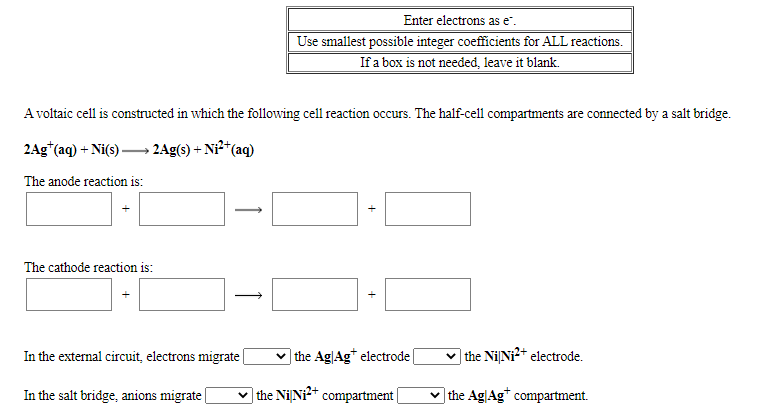A voltaic cell is constructed in which the following cell reaction occurs. The half-cell compartments are connected by a salt bridge. 2Ag*(aq) + Ni(s) → 2Ag(s) + N²*(aq) The anode reaction is: The cathode reaction is: In the external circuit, electrons migrate | the AglAg* electrode v the Ni[Ni²* electrode. In the salt bridge, anions migrate | the NiNi²* compartment |the Ag|Ag* compartment. +
A voltaic cell is constructed in which the following cell reaction occurs. The half-cell compartments are connected by a salt bridge. 2Ag*(aq) + Ni(s) → 2Ag(s) + N²*(aq) The anode reaction is: The cathode reaction is: In the external circuit, electrons migrate | the AglAg* electrode v the Ni[Ni²* electrode. In the salt bridge, anions migrate | the NiNi²* compartment |the Ag|Ag* compartment. +
Chemistry & Chemical Reactivity
9th Edition
ISBN:9781133949640
Author:John C. Kotz, Paul M. Treichel, John Townsend, David Treichel
Publisher:John C. Kotz, Paul M. Treichel, John Townsend, David Treichel
Chapter19: Principles Of Chemical Reactivity: Electron Transfer Reactions
Section: Chapter Questions
Problem 9PS: The half-cells Fe2+(aq) | Fe(s) and O2(g) | H2O (in and solution) are linked to create a voltaic...
Related questions
Question

Transcribed Image Text:Enter electrons as e".
Use smallest possible integer coefficients for ALL reactions.
If a box is not needed, leave it blank.
A voltaic cell is constructed in which the following cell reaction occurs. The half-cell compartments are connected by a salt bridge.
2Ag*(aq) + Ni(s) → 2Ag(s) + Ni**(aq)
The anode reaction is:
The cathode reaction is:
In the external circuit, electrons migrate |
v the Ag|Ag* electrode
the NiNi?* electrode.
In the salt bridge, anions migrate|
v the NiNi* compartment|
v the AglAg* compartment.
Expert Solution
This question has been solved!
Explore an expertly crafted, step-by-step solution for a thorough understanding of key concepts.
Step by step
Solved in 2 steps with 2 images

Knowledge Booster
Learn more about
Need a deep-dive on the concept behind this application? Look no further. Learn more about this topic, chemistry and related others by exploring similar questions and additional content below.Recommended textbooks for you

Chemistry & Chemical Reactivity
Chemistry
ISBN:
9781133949640
Author:
John C. Kotz, Paul M. Treichel, John Townsend, David Treichel
Publisher:
Cengage Learning

Chemistry & Chemical Reactivity
Chemistry
ISBN:
9781337399074
Author:
John C. Kotz, Paul M. Treichel, John Townsend, David Treichel
Publisher:
Cengage Learning

Chemistry: An Atoms First Approach
Chemistry
ISBN:
9781305079243
Author:
Steven S. Zumdahl, Susan A. Zumdahl
Publisher:
Cengage Learning

Chemistry & Chemical Reactivity
Chemistry
ISBN:
9781133949640
Author:
John C. Kotz, Paul M. Treichel, John Townsend, David Treichel
Publisher:
Cengage Learning

Chemistry & Chemical Reactivity
Chemistry
ISBN:
9781337399074
Author:
John C. Kotz, Paul M. Treichel, John Townsend, David Treichel
Publisher:
Cengage Learning

Chemistry: An Atoms First Approach
Chemistry
ISBN:
9781305079243
Author:
Steven S. Zumdahl, Susan A. Zumdahl
Publisher:
Cengage Learning

Chemistry
Chemistry
ISBN:
9781305957404
Author:
Steven S. Zumdahl, Susan A. Zumdahl, Donald J. DeCoste
Publisher:
Cengage Learning

